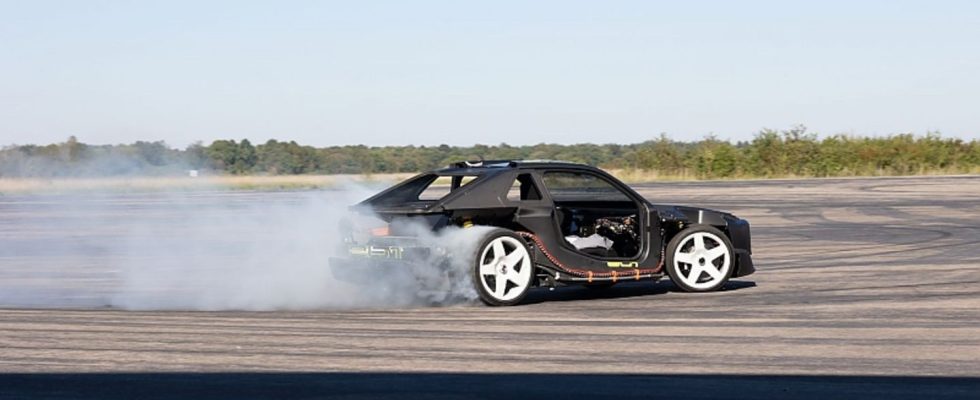Fascination: ELegend EL1
Legitimate successor
ELegend EL 1
© press-inform – the press office
The Bavarian start-up ELegend wants to bring iconic cars back to life as electric vehicles. First up is the 600 kW / 816 hp EL1, which is based on the famous Audi Sport Quattro S1. A first ride is exciting.
Electric cars have no soul. Are electric cars only for sensible people? Correct? Incorrect! A close-knit group from Beilngries in Upper Bavaria has set out to prove the opposite. As the name E-Legend suggests, it shouldn’t be a thousand and first hypercar with a brutal 2,500 hp that first breaks the sound barrier when shooting straight ahead and then smashes the tires to shreds, but rather one Car that puts a grin of anticipation on the driver’s face as soon as it is unlocked. “We don’t want to build a simple restomod, but rather a car that is a track tool and suitable for everyday use at the same time,” explains Marcus Holzinger, one of the founders of ELegend AG.
The name is program. A Stromer, yes, but not an ordinary one. So the Elegend El 1 is a modern version of the Audi Sport Quattro S1, i.e. the car that the Ingolstadt sports car manufacturer should have put on the wheels long ago. The group from the neighborhood of the brand with the four rings are not old-timers who just take a few electric motors in the garage and combine them into an electrocution soapbox. Marcus Holzinger is a trained industrial designer who has worked for VW and now runs his father’s design studio.
You can see from the EL1 that Holzinger has mastered his job. With a length of just 4.15 meters, an agility-enhancing wheelbase of 2.44 meters and an output of 600 kW / 816 hp, this electric car is the legitimate successor to the legendary rally all-wheel drive vehicle. So why an Audi Sport Quattro S1? “My father was involved in the design of the Sport Quattro,” says Marcus Holzinger. But a nice cover doesn’t make a fun car. The technology and agility also have to be right. Ultimately, the descendant of the rally icon is to be built 30 times by hand and sold for a price of 890,000 euros plus tax. More legends will follow later. “We want to build a car that follows the tradition of Group B rallying, vehicles and hill climbs. What’s important to us is traction out of corners, not top speed”; explains Günther Riedl, who is responsible for technology. In the spirit of the legendary Audi role model, this means no torque vectoring or other modern bells and whistles, just a classic limited-slip differential on the rear axle.
Riedl is anything but a newbie who tries his hand at dynamic construction kits, but is the boss of Roding Automobile, a company that implements projects for automobile manufacturers. From planning to prototypes. In addition, there is expertise in carbon construction, which is an advantage for the EL1 and all subsequent models. The monocoque is made of composite material and has an aluminum frame at the front and rear. This makes it easier to create different structures, i.e. models, without changing the monocoque as the core of the car and having to constantly build new tools. With carbon this would be a not entirely trivial and not entirely cheap task.
We take a close look at the shell of the so-called rolling chassis, which looks like a vehicle from the apocalyptic spectacle Mad Max, before we take a seat in the passenger seat. The workmanship is flawless. The carrier belt is lashed and the driver Mark is ready to go. Fire free. Mark lets the vehicle fly and accelerates as soon as he turns the steering wheel for the first time. The tires immediately spin and the smell of burnt rubber wafts around our noses. Nevertheless: The all-wheel drive with the two electrically excited synchronous machines, which produce a maximum of 150 kW / 204 HP at the front and 450 kW / 612 HP at the rear, is already doing its job pretty well. The rear axle is in command and steers along eagerly. This is also due to the basic power distribution of 35 (front) to 65 percent (rear).
Even if the fine-tuning is only at the beginning and the technicians are still fine-tuning the exact power distribution, the vehicle can still fly quite nicely. A slight tendency to understeer and a cocky rear end when reacting to load changes, which is immediately counteracted by countersteering and braking. “I can let it drift too,” says Mark, smiling. “Here we go”. The next second we are shooting across Wallachia and our stomach tells us that we shouldn’t have been so bold.
While most of the technical components are purchased from well-known suppliers, the drive control software remains the expertise of the team from Beilngries. The battery modules come from LG and have a capacity of 80 kilowatt hours, which, according to the fathers of the fun vehicle, is good for a consumption of around 20 kWh/100 kilometers and a WLTP range of more than 400 kilometers. The relatively low weight of 1,790 kilograms for such an electric vehicle helps. Sounds promising. We are looking forward to the first test drive. It will be exciting to see what Walter Röhrl says about this car. After all, the two-time rally world champion is not a fan of electromobility. Maybe the new edition of his Quattro rocket will change his mind.

